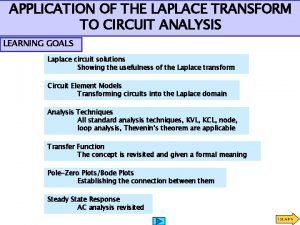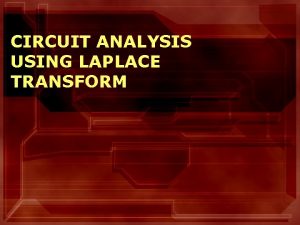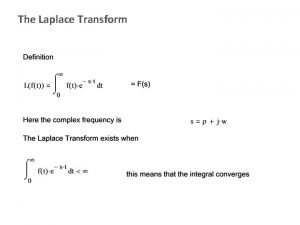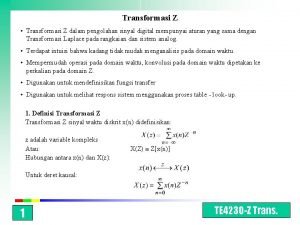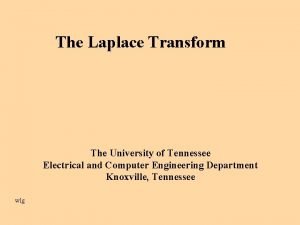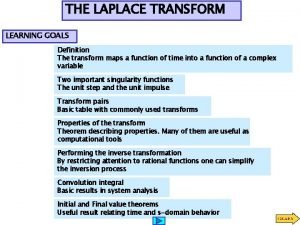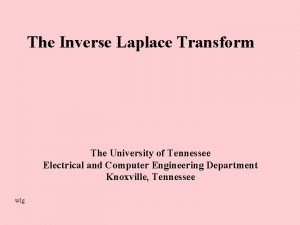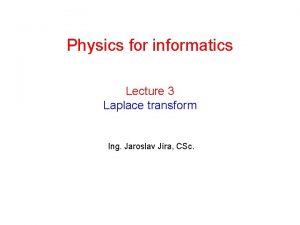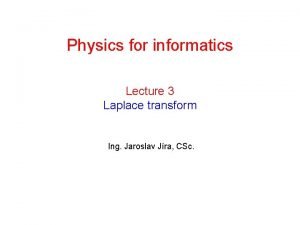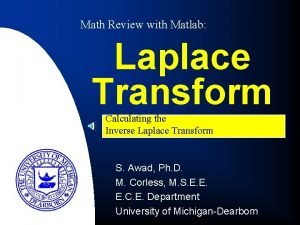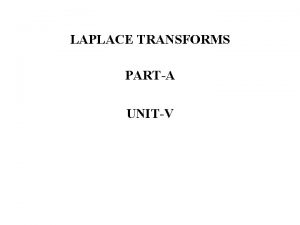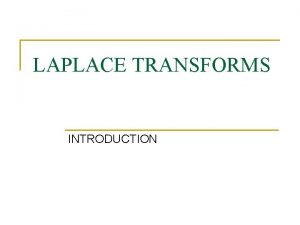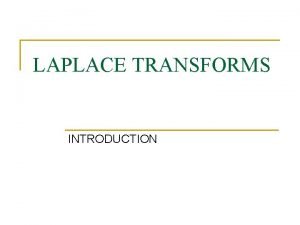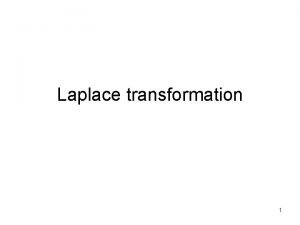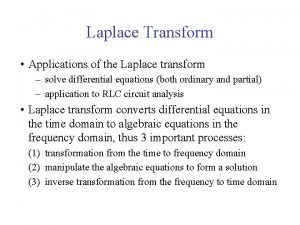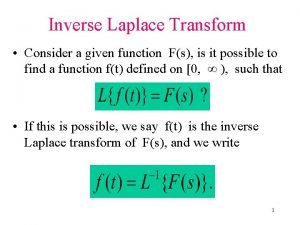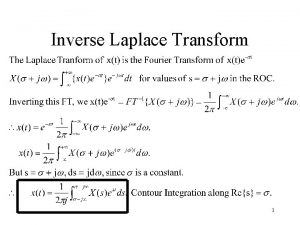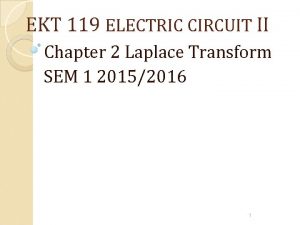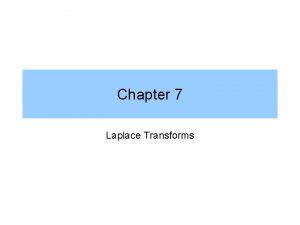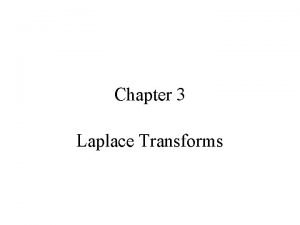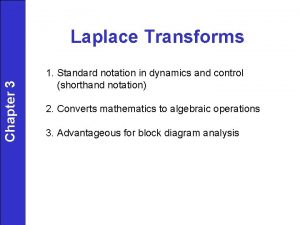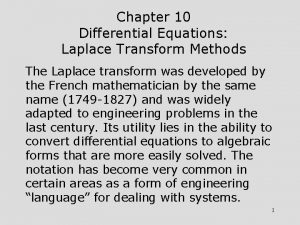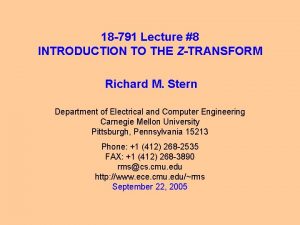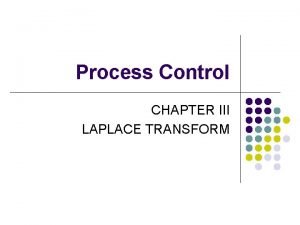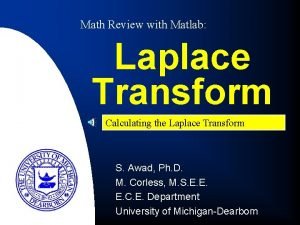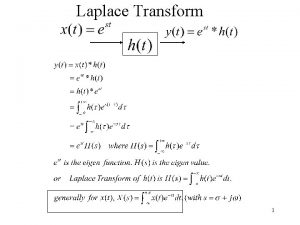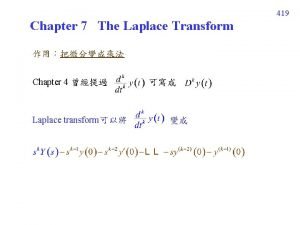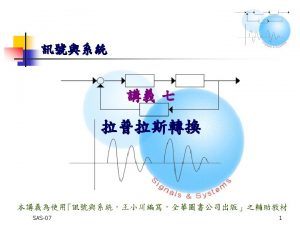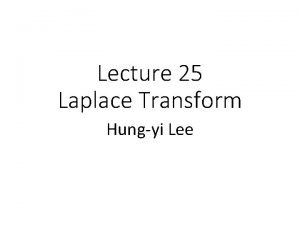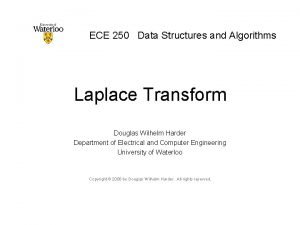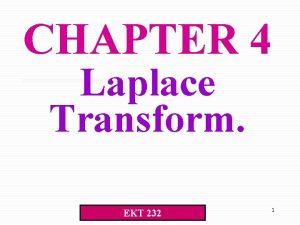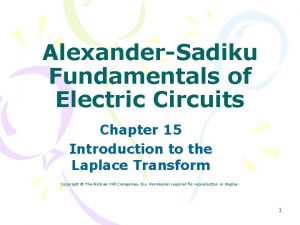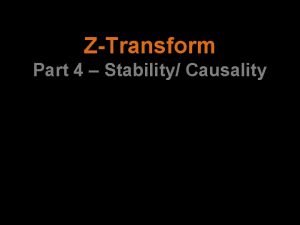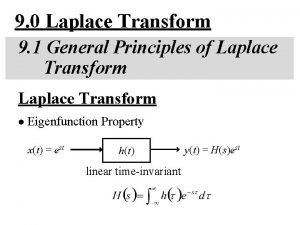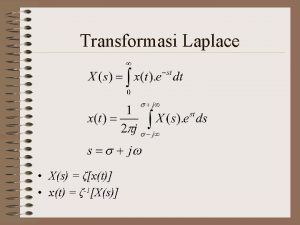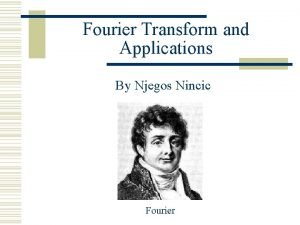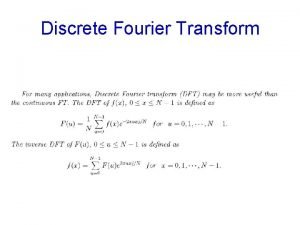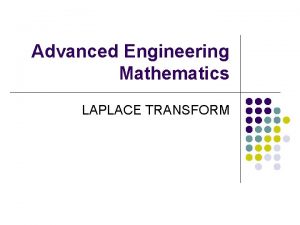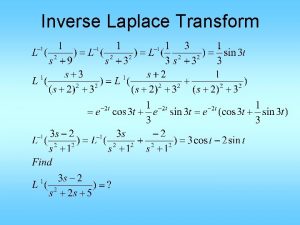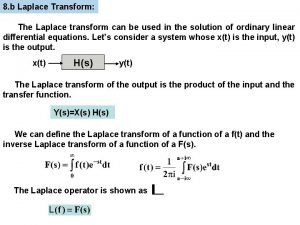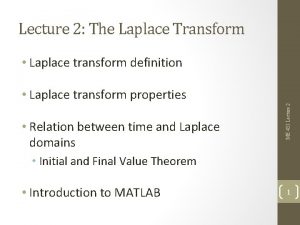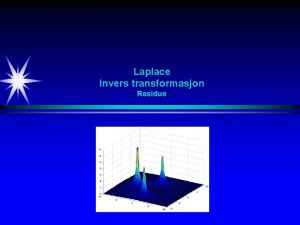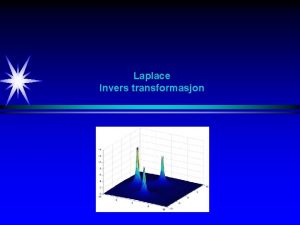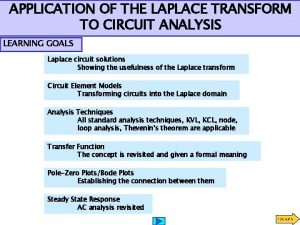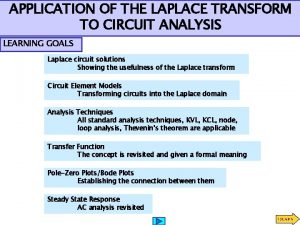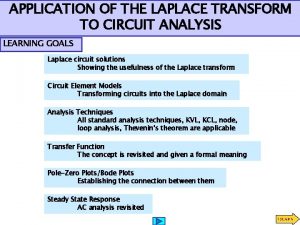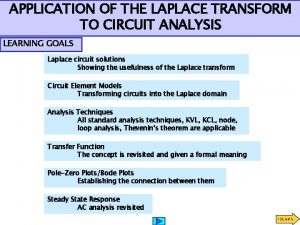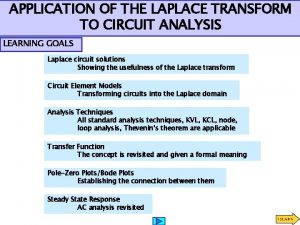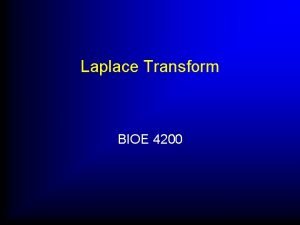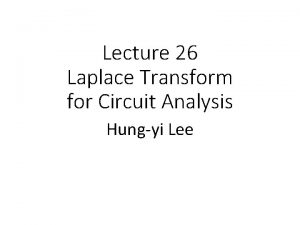APPLICATION OF THE LAPLACE TRANSFORM TO CIRCUIT ANALYSIS













































- Slides: 45

APPLICATION OF THE LAPLACE TRANSFORM TO CIRCUIT ANALYSIS LEARNING GOALS Laplace circuit solutions Showing the usefulness of the Laplace transform Circuit Element Models Transforming circuits into the Laplace domain Analysis Techniques All standard analysis techniques, KVL, KCL, node, loop analysis, Thevenin’s theorem are applicable Transfer Function The concept is revisited and given a formal meaning Pole-Zero Plots/Bode Plots Establishing the connection between them Steady State Response AC analysis revisited

LAPLACE CIRCUIT SOLUTIONS We compare a conventional approach to solve differential equations with a technique using the Laplace transform Comple mentary P a r t i c u l a r “Take Laplace transform” of the equation Initial conditions are automatically included Only algebra is needed No need to search for particular or complementary solutions

LEARNING BY DOING In the Laplace domain the differential equation is now an algebraic equation Use partial fractions to determine inverse Initial condition given in implicit form

CIRCUIT ELEMENT MODELS The method used so far follows the steps: 1. Write the differential equation model 2. Use Laplace transform to convert the model to an algebraic form For a more efficient approach: 1. Develop s-domain models for circuit elements 2. Draw the “Laplace equivalent circuit” keeping the interconnections and replacing the elements by their s-domain models 3. Analyze the Laplace equivalent circuit. All usual circuit tools are applicable and all equations are algebraic. Resistor

Capacitor: Model 1 Capacitor: Model 2 Source transformation Impedance in series with voltage source Impedance in parallel with current source

Inductor Models

Mutual Inductance Combine into a single source in the primary Single source in the secondary

LEARNING BY DOING Determine the model in the s-domain and the expression for the voltage across the inductor Steady state for t<0 Inductor with initial current Equivalent circuit in s-domain

ANALYSIS TECHNIQUES All the analysis techniques are applicable in the s-domain LEARNING EXAMPLE Draw the s-domain equivalent and find the voltage in both s-domain and time domain One needs to determine the initial voltage across the capacitor

LEARNING EXAMPLE Write the loop equations in the s-domain Do not increase number of loops

LEARNING EXAMPLE Write the node equations in the s-domain Do not increase number of nodes

LEARNING EXAMPLE Assume all initial conditions are zero Node Analysis Could have used voltage divider here

Loop Analysis

Source Superposition Applying current source Current divider Applying voltage source Voltage divider

Source Transformation The resistance is redundant Combine the sources and use current divider

Using Thevenin’s Theorem Reduce this part Voltage divider Only independent sources

Using Norton’s Theorem Reduce this part Current division

LEARNING EXAMPLE Selecting the analysis technique: Transforming the circuit to s-domain . Three loops, three non-reference nodes. One voltage source between non-reference nodes - supernode. One current source. One loop current known or supermesh. If v_2 is known, v_o can be obtained with a voltage divider

Continued. . . -keep dependent source and controlling variable in the same sub-circuit -Make sub-circuit to be reduced as simple as possible -Try to leave a simple voltage divider after reduction to Thevenin equivalent

Continued … Computing the inverse Laplace transform Analysis in the s-domain has established that the Laplace transform of the output voltage is One can also use quadratic factors. . .

LEARNING EXTENSION supernode KCL at supernode Assume zero initial conditions Implicit circuit transformation to s-domain

LEARNING EXTENSION supermesh Solve for I 2 Determine inverse transform

TRANSIENT CIRCUIT ANALYSIS USING LAPLACE TRANSFORM For the study of transients, especially transients due to switching, it is important to determine initial conditions. For this determination, one relies on the properties: 1. Voltage across capacitors cannot change discontinuously 2. Current through inductors cannot change discontinuously LEARNING EXAMPLE Assume steady state for t<0 and determine voltage across capacitors and currents through inductors Circuit for t>0

Now determine the inverse transform Laplace Circuit for t>0 Use mesh analysis Solve for I 2

LEARNING EXTENSION Initial current through inductor Current divider

LEARNING EXTENSION Determine initial current through inductor Use source superposition

TRANSFER FUNCTION System with all initial conditions set to zero H(s) can also be interpreted as the Laplace transform of the output when the input is an impulse and all initial conditions are zero The inverse transform of H(s) is also called the impulse response of the system If the impulse response is known then one can determine the response of the system to ANY other input

LEARNING EXAMPLE In the Laplace domain, Y(s)=H(s)X(s)

Impulse response of first and second order systems First order system Normalized second order system

LEARNING EXAMPLE Transform the circuit to the Laplace domain. All initial conditions set to zero Mesh analysis

LEARNING EXAMPLE Determine the transfer function, the type of damping and the unit step response Transform the circuit to the Laplace domain. All initial conditions set to zero

LEARNING EXTENSION x O x Determine the pole-zero plot, the type of damping and the unit step response

Second order networks: variation of poles with damping ratio Normalized second order system LEARNING EXAMPLE

LEARNING EXAMPLE The Tacoma Narrows Bridge Revisited Previously the event was modeled as a resonance problem. More detailed studies show that a model with a wind-dependent damping ratio provides a better explanation Torsional Resonance Model Problem: Develop a circuit that models this event

model integrator adder Using numerical values Simulation building blocks Simulation using dependent sources

Simulation results Wind speed=20 mph initial torsion=1 degree Wind speed=35 mph initial torsion =1 degree

POLE-ZERO PLOT/BODE PLOT CONNECTION Bode plots display magnitude and phase information of They show a cross section of G(s) If the poles get closer to imaginary axis the peaks and valleys are more pronounced Cross section shown by Bode

Cross section Due to symmetry show only positive frequencies Front view Amplitude Bode plot Uses log scales

STEADY STATE RESPONSE Response when all initial conditions are zero Laplace uses positive time functions. Even for sinusoids the response contains transitory terms EXAMPLE If interested in the steady state response only, then don’t determine residues associated with transient terms transient Steady state response For the general case

LEARNING EXAMPLE Determine the steady state response Transform the circuit to the Laplace domain. Assume all initial conditions are zero

LEARNING EXTENSION Transform circuit to Laplace domain. Assume all initial conditions are zero Thevenin

LEARNING BY APPLICATION De-emphasize bass Pole-zero map for Enhances bass to original level The playback filter is the reciprocal Pole/zero of playback filter cancels pole/zero of recording filter

LEARNING BY DESIGN Filtering noise in a data transmission line Data bits at 1000 bps Noise source is 100 k. Hz SOLUTION: Insert a second order low-pass filter in the path. Should not affect data signal and should attenuate noise Proposed filter Design equations Well below 100 k above 1 k Filter design criteria Below 100 k

Selected pole location or filter The filter eliminates noise but smooths data pulse noise 25 kbps data transfer rate Filtered signal is useless Circuit simulating the filter REDESIGN!

New pole-zero selection Simulation for 25 kbps APPLICATION LAPLACE
 Laplace transform circuit analysis examples
Laplace transform circuit analysis examples S domain circuit analysis
S domain circuit analysis Transfer function table
Transfer function table Pengertian transformasi z
Pengertian transformasi z State initial value theorem for laplace transform
State initial value theorem for laplace transform Laplace transform of 1
Laplace transform of 1 Laplace transform with complex roots
Laplace transform with complex roots Advantages of laplace transform
Advantages of laplace transform Laplace transform differential equation
Laplace transform differential equation Laplace transform of differential equation
Laplace transform of differential equation Matlab partial fraction expansion
Matlab partial fraction expansion Laplace transform of impulse
Laplace transform of impulse What is s in laplace transform
What is s in laplace transform Laplace transform
Laplace transform Laplace transform of a constant
Laplace transform of a constant Laplace definition
Laplace definition Convolution theorem
Convolution theorem Inverse laplace formulae
Inverse laplace formulae Laplace transform symbol
Laplace transform symbol Use of laplace transform
Use of laplace transform Heaviside method
Heaviside method Laplace table
Laplace table Unit step function examples
Unit step function examples Z transform vs laplace
Z transform vs laplace Table of inverse laplace transform
Table of inverse laplace transform Matlab laplace transform
Matlab laplace transform Relationship between laplace and fourier transform
Relationship between laplace and fourier transform Integration of dirac delta function
Integration of dirac delta function Region of convergence in laplace transform
Region of convergence in laplace transform Final value theorem transfer function
Final value theorem transfer function Laplace derivative
Laplace derivative Unilateral laplace transform
Unilateral laplace transform Find the laplace transform of 15/2
Find the laplace transform of 15/2 Stability and causality of z transform
Stability and causality of z transform Unit impulse function laplace
Unit impulse function laplace Laplace transform
Laplace transform Laplace transform piecewise
Laplace transform piecewise Laplace inductor
Laplace inductor Application of discrete fourier transform
Application of discrete fourier transform 2d discrete fourier transform
2d discrete fourier transform V
V Types of circuit
Types of circuit Circuit construction kit
Circuit construction kit Voltage and current series parallel
Voltage and current series parallel Difference between complete circuit and incomplete circuit
Difference between complete circuit and incomplete circuit Short circuit example
Short circuit example
